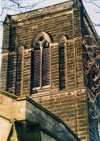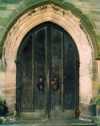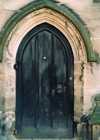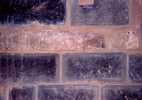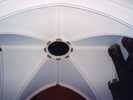For this church:    |
Sneinton St StephenArchaeology
The building is generally cruciform in shape, with the addition of low vestries on each side of the chancel. The tower and parts of the transept walls are from the Rickman and Hussey building of 1839. The rest of the church was built in 1909-1912 by C G Hare of Bodley and Hare. It was built around the previous church which was then demolished. The chancel was consecrated in 1909 and the nave in 1912. Part of the south transept was damaged by a German air raid in May 1941; some of the windows were not permanently reinstated until 1946. The exterior fabric of the building is of local stone throughout. The main exterior walls of the 1912 building are of irregular coursed ashlar dressed stone, rising from a two stage moulded plinth and extended above the gutter line, and capped with slightly more ornate copings. The visible stonework of the Rickman 1839 tower is laid in regular courses. Buttresses are located at each of the four corners of the linear axis and along the north and south walls in line with the internal pillars which support the nave arches. There are also buttresses on the end walls of the transept. The central stone tower now has a very dark appearance. In fact, it appears completely black when viewed from surrounding streets. Just above the apex of the adjoining roofs a roundel is set into each of the four elevations of the tower. The west and north faces are fitted with clock dials; the east and south have plain translucent infill. Over the roundels is a small plinth from which rises a two light opening in-filled with wooden louvres providing the ventilation, and sound release for the belfry. On either side of these lights is a narrow single blind light. Originally, the tower had pinnacles at each corner but two were blown off during a storm in 1860, and the others were removed for safety reasons.
Most of the window openings house a two-light lancet window with central spine and simple tracery over. There is some variation in the tracery. All the windows have moulded drip arches which are linked by a similar moulding horizontally from the springing points. Otherwise, the surrounding stone work is plain. The west window opening is similar but larger, having two pairs of lights with slightly more ornate tracery, and an area of decorative recessed stonework below the sill. A small two-light mullioned window is located at high level above the west door.
Small entrance doors give access direct to the vestries. There is a small single door which is regularly used, in the north wall adjacent to the transept. The main double doors are situated at the north-west corner of the church. A similar pair of doors is set at the south-west corner but have long since been sealed. All the doors are arched and set within recessed, moulded arches surmounted by arched drip mouldings. Originally, and until at least the 1960s, most of the roofs were covered in sheet lead. All of the visible roof coverings now have modern concrete tiles. The rainwater disposal system is a mixture of the 1912 rectangular lead pipes with embossed cast lead heads. Both round and rectangular cast iron pipes and some modern plastic replacements are evident.
On the internal walls of the nave the plaster has been removed to a height of about two metres, level with the sills of the windows. The stonework is constructed of larger blocks than the outer skin and is laid un-coursed. Like the outer face, it appears to be local limestone, though much of it is dark in colour. This colour may be due to environmental factors. The walls of the transepts are plastered and painted white. Part of St George’s Chapel is ornately panelled and painted crimson to compliment the reredos. The chancel walls are coursed ashlar stonework, with oak panelling at a height of two metres, covering the walls from each side of the reredos to the outside walls. Parts of the transept walls are from the 1839 church. The nave has four moulded piers on each side forming the arcades and supporting the main roof plus fronting the bays of the aisles. At right angles from each pier a lower arch, with exposed stonework below surmounted by plastered and painted brick or stone, connects to the external wall over the aisles. Due to the asymmetry of the transepts, the south aisle ends with two arches leading to the extended south transept housing the Lady Chapel and St Anthony’s Chapel whist the north aisle has only one arch giving access to St George’s Chapel in the north transept. The nave has a wooden barrel vaulted ceiling with moulded ribs painted in green and gold. Each of the main curved rafters leads from a stone corbel which, in turn, is supported by a stone spine rising from the springing points of the arches below. A carved wood border connects each rafter to the next.
In contrast, the ceilings of the side aisle are white painted concrete arches. Although the ceiling of the transept crossing is also painted white it is much more ornate. It has eight ribs converging on a central circular ventilation grill. Each rib is terminated by a decorated gilt boss. The chancel ceiling is, again, entirely different. It is completely flat covered with plain oak panels. At the intersection of the panels an ornate gilt boss of a central flower projecting four, four- petaled flowers forming a square enriches the plainness of the oak. Other than the entrance doors described above, internal doors beyond the choir stalls in the chancel lead to vestries on either side. On the south side, the vestry has a sink and is used for various purposes. Set at an angle in the corner of this room is a door giving access to the tower. On the north side is the choir vestry and a further door leading to the vicar’s vestry. Inside the double west doors there is an inner porch and a pair of part-glazed doors possibly from the 1930s. In the southwest corner the external door has been sealed and an area has been partitioned to form a toilet facility. The chancel floor has alternating black and white marble tiles of varying sizes laid in a diagonal pattern from the chancel screen to the steps of the high altar. Heating grills are incorporated into the design. A plain red carpet covers the central aisle of the nave, with a patterned red carpet over the altar steps. The main area of the nave has wood block flooring under the chairs and stone slabs in the side aisles. The tower has two floors, and is accessed via a wrought iron spiral staircase set in a brick shaft leading from a door in the south vestry. The staircase terminates at the former entrance to the organ loft. Access to the first floor and the clock must be made by ascending a vertical ladder secured to the wall. In the corner of the clock room is another pole ladder set at a steep angle, giving access to the next level housing the bells. Access to the roof of the tower is through a trap door at the top of another pole ladder. | |||||||||||


